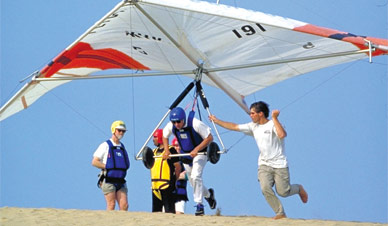The view from the top of Jockey’s Ridge is one of the most spectacular on the Outer Banks. To the east, the waves of the Atlantic break upon the beaches of Nags Head, and to the west, the dune line slopes gradually to the open waters of the Roanoke Sound. The landscape at the top of the dune is like an image from some other world. There is nothing but sand and wind and the sun – no trees, no grass – a vision of the most desolate desert imaginable.
 Yet this desolate landscape is a place filled with the joy of life. There is perhaps no better place anywhere to fly a kite – with nothing to stop the wind in any direction, it is a rare day that a kite won’t soar into the sky.
Yet this desolate landscape is a place filled with the joy of life. There is perhaps no better place anywhere to fly a kite – with nothing to stop the wind in any direction, it is a rare day that a kite won’t soar into the sky.
It is a spectacular sight, especially during the summer. Dozens of kites paint the sky: single-line deltas and diamond kites, some with tails trailing far below them. Two-line and four-line stunt kites dance across the horizon. And everywhere is the sound of children laughing and parents filled with the joy of being kids again.
Even the biggest kites launch from the slopes of Jockey’s Ridge. The park is the home of Kitty Hawk Kites, the largest hang-gliding school in the world. It is a sublime and extraordinary moment when your feet leave the ground and you realize that you are in fact flying!
Yet Jockey’s Ridge State Park is much more than a launching pad for kites. The park is an ecological wonder, a dynamic and ever-changing environment whose geological history is the history of the Outer Banks themselves. Jockey’s Ridge is an example of a “medano”– a sand dune devoid of any vegetation. Because there is no vegetation anchoring the sand at the top of a medano, the elevation tends to vary with the wind and the seasons. Jockey’s Ridge is the largest sand dune on the East Coast and varies in height from 80’ to 100’.
Within the boundaries of the park are distinct ecological systems. The visitors center’s parking lot and walkway are set amidst a small forest of live oak, wax myrtle, bayberry and red cedar. In a protected pocket at the western edge of the dune, a small copse of red oak, hickory, sweet gum and loblolly pine has taken root.
Soundside Natural Trail
Along the soundside shoreline, a wide variety of marsh grasses and sub-aquatic vegetation that are essential to the survival of migratory waterfowl thrive. Early morning visitors who look carefully at the sand will see deer, raccoon, fox and possum tracks. There are two self-guided nature trails within the park boundaries. The Soundside Natural Trail is about one mile in length and traverses a number of wetland zones. Tracks in the Sand is a 1.5-mile loop marked by 14 stations. Although not the traditional well-packed ground of a woodlands path, the trail is easy to follow and winds its way through largely unexplored areas of the park.
Jockey’s Ridge State Park
300 W Carolista Dr, Nags Head, NC 27959
